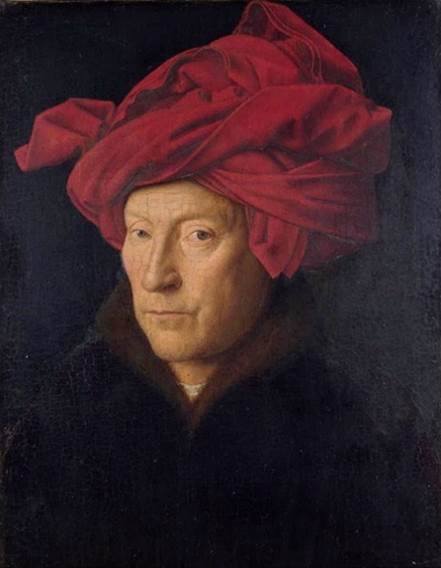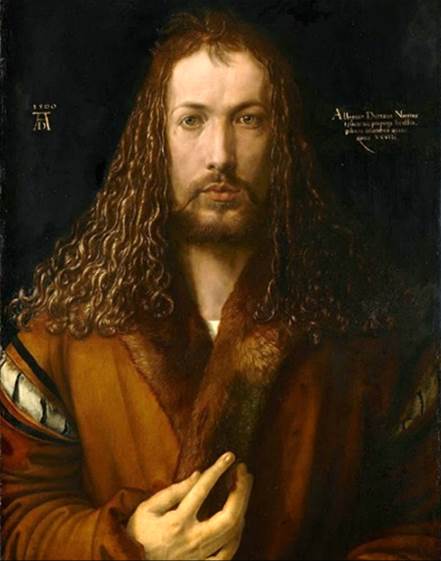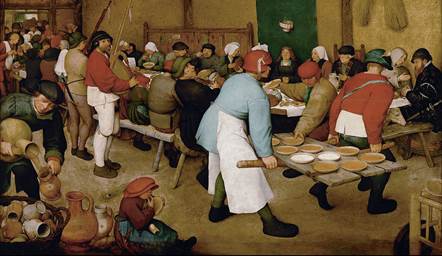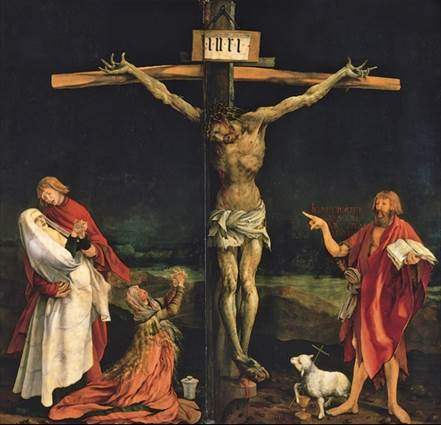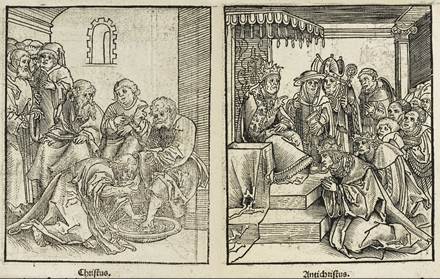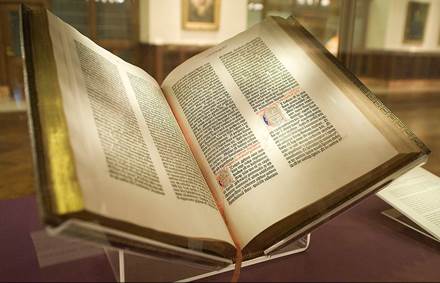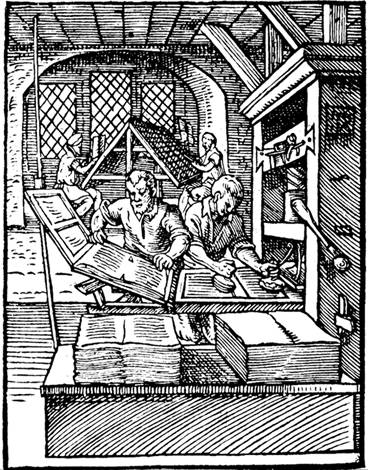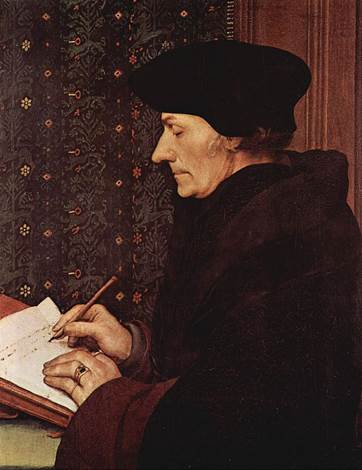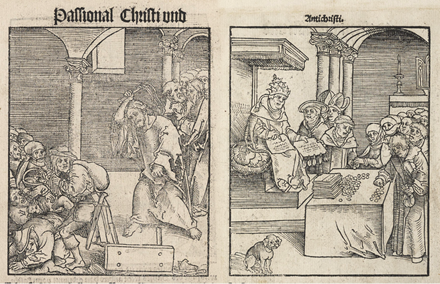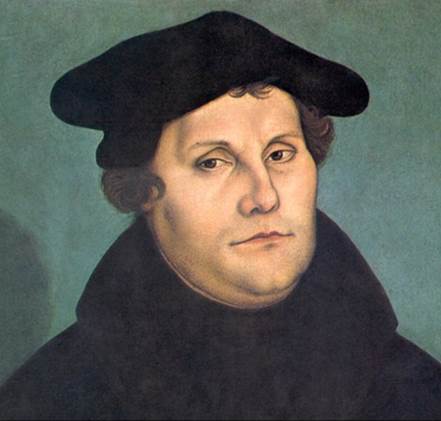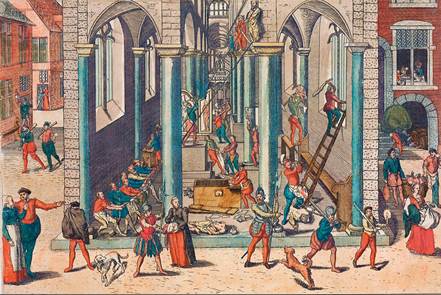The Renaissance quickly spread from Italy to the rest of Europe, where it became especially influential in Germany and Flanders. Whereas the Italian humanists had largely left the Catholic doctrine undisturbed, the humanists of Western Europe attacked it head on. They demanded people should be able to read the Bible for themselves and come to their own conclusions without the intervention of the Church. This became increasingly possible due to the translation of the Bible into various vernacular languages and the distribution of the Gutenberg Bible, produced by the newly invented printing press.
The humanist philosopher Erasmus bravely criticized the hypocrisies of the Church in an attempt to reform it from within, but when the Church proved unwilling to change, Martin Luther fractured its hegemony, creating his own branch of Christianity. With this act, he ushered in the period known as the Reformation.
In the arts, painters such as Jan van Eyck began to paint portraits with unprecedented realism. Where their Italian counterparts had idealized the human form, the northern artists celebrated human beings as they truly were, including their flaws. Pieter Bruegel the Elder even immortalized common peasants and workers.
Northern Renaissance art
Like their Italian counterparts, the artists of the Northern Renaissance set the individual center stage, but they did so in a different way. This is especially apparent in their portraits, which were less idealized, missing the grandeur that came with perfect anatomical proportions and extreme perspective, but were more credible and personal through their realism and their unprecedented attention to detail. For instance, Fig. 428 shows a work by the great Flemish artist Jan van Eyck (c. 1390–1441), who is often considered to be the founder of Flemish Renaissance art (he was a contemporary of Masaccio and predated Leonardo and Michelangelo). Fig. 429 shows a self-portrait by the German painter Albrecht Dürer (1471–1528). Dürer famously traveled to Italy, where he met Leonardo and Raphael. Inspired by their work, he became one of the first northern artists to embrace both classical themes and the use of perspective. His self-portrait reflects his pride, both through his direct gaze, which was usually only reserved for religious figures, and through his Christlike appearance.
Fig. 428 – Portrait of a man by Jan van Eyck (1433) (National Gallery, Britain)
Fig. 429 – A self-portrait by Albrecht Dürer (Alte Pinakothek, Germany)
Pieter Bruegel the Elder (c. 1525–1569) took the next step by making average people the center of attention. He painted commoners—even peasants—during their daily activities. In this way, he gave voice to the poor and celebrated their lives (see Fig. 430).
Fig. 430 – The Peasant Wedding by Pieter Bruegel the Elder (1566 AD) (Kunsthistorisches Museum, Austria)
The Isenheim Altarpiece (see Fig. 431) by Matthias Grünewald (c. 1470–1528) gave solace to those suffering from illness. It shows Christ on the cross, but not with the usual sense of nobility and supernatural grace. Instead, we see intense and gruesome suffering. Jesus is covered with wounds, his lips have turned blue, his body is contorted, and his fingers have twisted. The work was made for a monastery specialized in the care of plague patients. Matthias wanted to convey to them that Jesus understood and shared their afflictions. The other side of the altarpiece gave hope, showing Christ emerging from his tomb and ascending to heaven in a halo of light. These images evoked strong emotional responses, allowing commoners to feel a strong connection with God.
Fig. 431 – The Isenheim Altarpiece by Matthias Grünewald (1512 AD) (Unterlinden Museum, France)
Interestingly, Michelangelo claimed he didn’t understand northern art. He recognized its superior ability to evoke emotions, but he was put off by its lack of idealistic grandeur and symmetry. We read:
Flemish painting will, generally speaking, please the devout better than any painting in Italy, which will never cause him to shed a tear, whereas that of Flanders will cause him to shed many; and that not through the vigor and goodness of the painting but owing to the goodness of the devout person. [...] In Flanders, they paint with the aim of external exactness, things that may cheer you and of which you cannot speak ill, as for example saints and prophets. They paint stuffs and masonry, the green grass of the fields, the shadow of trees, and rivers and bridges, which they call landscapes, with many figures on this side and many figures on that. And all this, though it pleases some people, is done without reason or art, without symmetry or proportion, without skillful judgment or boldness, and, finally, without substance or vigor. Nevertheless, there are countries where they paint worse than in Flanders. And I do not speak ill of Flemish painting because it is all bad but because it attempts to do so many things well (each one of which would suffice for greatness) that it does none well. [261]
The greatest composers from the 15th and the 16th century also came from Flanders. Similar to the visual artists, Renaissance musicians knew they were lifting their art to unseen heights. The music theorist Johannes Tinctoris (c. 1435–1511) even claimed nothing composed before 1430 was worth hearing. One of the great breakthroughs was an improvement in tuning. It turns out that all tuning systems are mathematically imperfect, with each system having its own ups and downs. Medieval musicians used the Pythagorean tuning system, which makes intervals of an octave, a fifth, and a fourth sound consonant, while thirds and sixths sound dissonant. The problem is that overly using fifths and octaves sounds a bit stiff to the modern ear. The Renaissance musicians changed the tuning with a preference for thirds and sixths.
The greatest musician of the time was Josquin Deprez (c. 1450–1521), who was born in northern France and trained in Flanders. He was the first composer to become genuinely famous during his lifetime. Contemporaries called him “the father of musicians” and compared him to Michelangelo:
Josquin […] may be said to have been, in music, a prodigy of nature, as our Michelangelo Buonarroti has been in architecture, painting, and sculpture; for just as there has not been anyone who in his compositions approaches Josquin, so Michelangelo, among all those who have been active in these arts, is still alone and without peer. Both of them have opened the eyes of all those who delight in these arts or will delight in them in the future. [262]
Like the visual artists, Renaissance musicians also wanted to look back to the ancients, but the Greeks and Romans had left them no music. The only thing they could go on was some music theory. The Greek philosophers had claimed that music had the power to move the soul, evoke powerful emotions, and even improve someone’s character. Wondering why the music of their day didn’t move them in the same way, the Renaissance musicians began to experiment with expressing emotion through music. The medieval troubadours had already experimented with emotional lyrics, but rarely expressed these lyrics in the way they played and sang. The Renaissance musicians, for instance, made an uplifting phrase sound happy and a depressing phrase sound down. Josquin, for example, used a descending line of notes to accompany the words “painful distress,” added a burst of energy on the words “and was resurrected,” and left the words “abandon you” dangling without a proper cadence, giving it a sense of imbalance. [262] One commentator wrote about Josquin’s most famous work Miserere mei, Deus (“Have mercy on me, O God”):
I beg whether anyone can listen so carelessly as not to be moved in his whole spirit and whole intellect towards contemplating the message of the Prophet [Nathan] more carefully, since the melodies conform to the feelings of one who is burdened by the magnitude of sin, and […] the very deliberate repetition by which [the sinner] begs for mercy does not permit the soul either to reflect idly or to fail to be moved toward hope of assurance. [262]
The Church in peril
During the Renaissance, the Church suffered from a number of setbacks from which it never fully recovered. Firstly, despite many attempts by the Church to monopolize Christianity, large-scale heretical movements kept popping up. Secondly, the Church had gained a reputation for being greedy, as it was hoarding an incredible amount of taxes from the working class. With this being in direct opposition to the teachings of Jesus, it strongly undermined their claim of spiritual purity. Capturing this sentiment, the great German artist Lucas Cranach the Elder (c. 1472–1553) made a number of etchings comparing Jesus to the pope. In Fig. 432, for instance, we see Jesus washing the feet of his disciples, while the pope, in contrast, demands that his subjects kiss his feet. Underneath the image of Jesus, we read “Christ,” while the word “Anti-Christ” was written under the picture of the pope.
Rulers also began to resent the flow of money from their kingdoms to the papacy. In the 13th century, this led to a conflict between the French king Philip IV (1268–1314) and Pope Boniface VIII (c. 1230–1303). When Philip decided to tax his clerics, which was against the rules of the Church, the pope retaliated by issuing a decree declaring that kings were subordinate to the pope. Philip was not impressed and sent soldiers to Rome, who pillaged and plundered the papal villa and held the pope hostage for three days. The pope died one month later, after which Philip forced a conclave to elect as his successor the French Clement V (c. 1264–1314). He then pressured Clement into staging a posthumous trial of Boniface, accusing him of heresy and sodomy. Pope Clement then moved the papacy from Rome to Avignon, where it remained for the next 67 years. In 1376, the French pope Gregory XI (c. 1329–1378) restored the papacy to Rome, but after his term, France instituted a pope of their own, leading to two simultaneous papacies. In 1409, an attempt was made to depose both popes, which led to the election of yet another pope. The problem was finally resolved in 1417 when Pope Martin V replaced all three competitors. Understandably, these events damaged the supposedly infallible Holy Church.
Fig. 432 – Image from Passional Christi und Antichristi by Lucas Cranach the Elder (1521). The left image shows Christ kissing the feet of disciples. The right image contrasts this with the pope, who demands his subjects to kiss his feet. Underneath the image, we read “Christus” and “Antichristus” (British Library)
Another disruption took place in Germany when Pope John XXII (1244–1334) was unwilling to support the coronation of Ludwig IV (1285–1347) as Holy Roman Emperor. In response, Ludwig marched on Rome, crowned himself at Saint Peter’s, and installed a new pope who confirmed his title. To defend himself theologically, Ludwig took under his protection a number of critics of the papacy. One of them was Marsilius of Padua (c. 1275–1342), an Italian scholar who had been rector of the University of Paris. Marsilius had caused great controversy with his Defensor Pacis (“Defender of Peace”), which is considered a landmark text in the secularization of the West. In this work, he claimed the papacy was far too corrupt to hold political power. Why, for instance, does the papacy own “so many unnecessary things—horses, estates, banquets, and other vanities and pleasures, open and concealed—when according to the Apostle [Paul], they ought to be content with food and shelter for ministering the gospel?” Marsilius also claimed that no one—not even the papacy—knew God’s will in matters of politics. As a result, the clergy had no business in politics and should make room for rulers who simply strife for the secular goal of attaining civil peace. Marsilius even proposed to take away the right of the papacy to interpret the Bible, claiming they had misused it to legitimize their papal bulls. Foreshadowing Martin Luther, Marsilius also stated that “for salvation it is necessary for us to believe in […] no statements […] except those which are […] contained in the volume of the Bible.” [259]
The second great critic under the protection of Ludwig was the English scholar William of Ockham (1287–1347), who (apocryphally) declared to Ludwig: “I will defend you with my pen, if you will defend me with your sword.” [259] William was a Franciscan monk, who—true to the Franciscan creed—strongly opposed the wealth of the papacy. He also accused Pope John of being a heretic, when he had claimed—contrary to his predecessors—that Jesus had owned property (making his own property less suspect). In his Letter to the Friars, William explained:
I stayed in Avignon almost four whole years before I recognized that the one who presided there had fallen into heretical perversity. […] I found a great many things that were heretical, erroneous, silly, ridiculous, fantastic, insane, and defamatory, contrary and likewise plainly adverse to orthodox faith, good morals, natural reason, certain experience, and fraternal charity. […] I gladly left Avignon to devote myself, in my small measure, to attacking that heretic and his heresies. [259]
Similar to Marsilius, William believed that these criticisms disqualified the papacy from holding political power. William also agreed that the pope had no business interpreting the Bible:
[It] is not permissible for the pope to interpret the words of God or Christ otherwise than it is for another, nor do we have to believe him in such matters more than any other wise man—indeed, in such matters those more expert than the pope should be preferred to the pope himself. [259]
A similar situation took place in England, where King Edward III (1312–1377) consistently ignored papal decrees. He was supported theologically by John Wycliffe (c. 1330–1384)—a contemporary of Petrarch. Radically, he claimed the Church should transfer all its property to the secular authorities. Wycliffe claimed this was for their own good, as this was the only way to restore the Church to Christlike poverty, allowing them to focus on preaching God’s word. He also claimed the Bible contains all that is necessary for salvation, making the Church unnecessary. While the Church had done its best to keep the Bible out of the hands of the masses to control its interpretation, Wycliffe claimed reading the Bible was “necessary for all men.” To make the Bible available to the people, he advocated it be translated into the vernacular:
It is certain that the truth of the Christian faith becomes more evident the more faith itself is known. Therefore, the doctrine should not only be in Latin but in the vulgar tongue. […] The laity ought to understand the faith and, as doctrines of our faith are in the Scriptures, believers should have the Scriptures in a language which they fully understand. [259]
To make this a reality, Wycliffe (or perhaps his followers) created the first complete translation of the Bible into English, known as the Wycliffe Bible.
Wycliffe’s critique on the Church’s wealth was taken up by the masses, who channeled their rage not just at the Church, but also at the aristocracy, who had burdened the people with an extra tax to finance the Hundred Years’ War. When a violent peasant revolt broke out in his name, during which the Archbishop of Canterbury was beheaded, Wycliffe immediately distanced himself, but he was nevertheless blamed. His books were confiscated and his ideas condemned.
After his death, Wycliffe’s ideas traveled to Bohemia (the Czech Republic), where they were picked up by John Hus (c. 1372–1415). Hus fought to have Wycliffe’s condemnation overturned, violently if necessary:
The time has come for us, just as it did for Moses in the Old Testament, to take up our swords and defend the law of God. [259]
In response to these threats, Hus was burned at the stake. His ideas, however, lived on, as he became a martyr. The papacy proclaimed five crusades against his followers, which the Hussites all won.
Hus had also been a strong critic of the papal practice of granting indulgences, which allowed people to buy off temporary punishments in purgatory, either for themselves or for their loved ones. According to Hus, the Church had no such powers. He also promoted the reading of the Bible and translated it into the Czech vernacular.
As the Church was embroiled in these all-too-human scandals, many Europeans decided to take matters into their own hands by developing their own religious practices. An especially popular practice was developed by the Dutch cleric Geert Groote (1340–1384), who was one of the pioneers of the Devotio Moderna movement. Groote’s teachings emphasized the value of simplicity, contemplation, and the individual study of religious texts. He also elevated the importance of spiritual growth over the ritualistic side of faith. These new movements made it possible for people to have a more personal and emotional connection with God and allowed for their active participation. This was in stark contrast to their experience with the Church, where the congregation often couldn’t even understand the Latin spoken by the priests.
The printing press
The power of the Church further diminished around 1450 with the invention of the movable-type printing press by Johannes Gutenberg (c. 1400–1468)[14]. In the Middle Ages, people had used parchment, which is made from animal skin. Creating parchment was extremely labor intensive, as the skin needed to be cleaned, stretched, and scraped and it took about 300 sheep to make a single Bible. Paper, which was much cheaper and easier to produce, was invented in China and first entered Europe in Arabic Spain, but it did not spread widely until a number of innovations were made which allowed it to be produced on an industrial scale. This happened in Fabriano, Italy, where in the early 14th century water-powered mills were deployed to make paper. A special glue was also developed that allowed the ink to absorb into the paper without spreading, allowing for razor-sharp lines. This glue had the added effect of keeping out moisture, bacteria, and fungi from the paper.
The first major work to be printed was the Gutenberg Bible (1455, see Fig. 433). The cheap printing costs and quick production made the Bible available to a much larger public, further encouraging the general public to read and interpret the Bible for themselves.
Gutenberg’s press ushered in the Printing Revolution. About 50 years after its invention, Europe counted as many as 1,000 print shops, which together produced an estimated 20 million books.
Fig. 433 – The Gutenberg Bible (Kevin Eng, CC BY-SA 2.0; NY Public Library, United States)
But the spread of cheap books wasn’t only positive, as it also allowed for the spread of political and religious propaganda, hate speech, obscene cartoons, and heretical treatises, which were all considered dangerous by many. Even the great humanist Erasmus, who had earlier promoted free speech—claiming that “in a free state, tongues too should be free”—eventually became critical, stating that printers “fill the world with pamphlets and books” that are “foolish, ignorant, malignant, libelous, mad, impious, and subversive; and such is the flood that even things that might have done some good lose all their goodness.” Martin Luther, when he was using the press to spread his message like no other, first called it “God’s highest […] act of grace, whereby the business of the Gospel is driven forward,” but once he himself gained a position of authority, he urged local elites to censor his opponents. [136]
Fig. 434 – An early depiction of a printing press by Jost Amman (1568). The person on the left is removing pages, while the person on the right is applying the ink.
Erasmus
While the Italian humanists had criticized the excesses of the Church and the papacy, they largely steered clear of criticizing Catholic doctrine.[15] Instead, their humanist endeavors focused mainly on reviving the pagan heritage of Greece and Rome. Humanists from Western Europe did not have this option, as they had much less access to pagan manuscripts. Their libraries did contain various Greek versions of the Bible, to which the Dutch philosopher Desiderius Erasmus (1466–1536) came to apply the Italian techniques of textual analysis. As a result, the Northern Renaissance is sometimes also called the Christian Renaissance.
Desiderius Erasmus, dubbed the prince of humanists, was the strongest advocate for humanism in the North, the best biblical scholar, and at his peak became the most successful writer in the world. Already during his schooling, he yearned to escape the narrow-minded approach of his teachers, who still used a medieval style of teaching. He despised the degraded medieval Latin of his teachers and instead educated himself using Lorenzo Valla’s manual called Elegances of the Latin Language. Erasmus also despised Thomas Aquinas’s pedantic and abstract theology as opposed to the work of Jerome, who had become an expert in the original languages of the Bible (Hebrew and Greek) and who had intelligibly written on the problems he faced when translating the Bible.
When Erasmus’s parents died, he was placed in a monastery, where the monks had even less interest in true learning. Studying the Bible, to them, was more like a meditation than proper study. During these years, Erasmus wrote Against the Barbarians, in which he attacked the intellectual backwardness of his education. He called his own teachers “illiterate barbarians” and accused them of ignoring everything valuable in the ancient texts, while focusing obsessively on insignificant details. By forbidding many classical texts, they had also made curiosity a sin. Meanwhile, Erasmus felt “like a mysterious force of nature pushed him towards [classical] literature.”
Even though the masters forbade it, if I ever got my hands on them, I would secretly devour books as much as I could. [178]
Fig. 435 – Erasmus by Hans Holbein (1523 AD) (Louvre, France)
When he went to the University of Paris, he was disappointed to find the same stifling atmosphere.
Nothing so pedantic as their minds, nothing so barbaric as their language, nothing so dull as their spirit, nothing so thorny as their doctrine, nothing so gross as their conduct, nothing so hypocritical as their way of life, nothing so venomous as their talk, nothing as black as their hearts. [178]
Then, in 1504, Erasmus discovered Lorenzo Valla’s Annotations—a text on the errors in Jerome’s Vulgate Bible—in a monastery library in Leuven, Belgium (see the previous chapter). Valla’s work was criticized in Italy, as the Vulgate was considered the officially sanctioned Bible translation of the Church, which had been used as the direct word of God for over a thousand years. Erasmus, however, immediately recognized the value of the Annotations, mass-produced it in print form, and spread it among the public. Erasmus also added a bold preface to the work, stating that Valla had done Christianity a service and that Valla, in his provocative writing style, had answered his critics “with a crackling fart.” [178] Erasmus claimed Valla was right to correct Jerome’s errors. Some critics took issue with Valla being a grammarian and not a theologian, but Erasmus rightly countered that Valla was able to read and interpret the New Testament in its original language, while most theologians could not. Through his textual analyses, Valla had shown that the translation of the Bible was an all-too-human task. The apostles had imperfectly translated their Semitic tongue into Greek, the Greek was later imperfectly translated into Latin, and then on top of all this there were the mistakes by the medieval copyists.
Inspired by Valla’s work, Erasmus then set himself the task to create an entirely new translation of the New Testament, which he named Novum Instrumentum omne (1516). It was the first full translation of the New Testament from the original Greek since the 4th century. Each page was divided into two columns, one with the Greek “urtext” and the other with Erasmus’s corrected Latin version. The Greek text would later be used in Germany for the Luther Bible and in England for the King James Bible. After the translation, Erasmus added 400 pages of notes and references, professionally explaining all the changes he had made to the Vulgate. Interestingly, Erasmus dedicated his Novum Instrumentum omne to Pope Leo X (1475–1521), the humanist pope who commissioned works by Michelangelo and Raphael. The pope responded positively.
Among the many errors he found in the Vulgate was the erroneous inclusion of a verse known as the Johannine Comma, which did not appear in the Greek versions of the Bible and was also absent in the oldest versions of the Vulgate. We now know the verse first sneaked in around 400 AD, first as a footnote and later as part of the main text. The omission was significant, since it was the only direct statement in the Bible confirming the Catholic doctrine of the trinity. The verse reads:
For there are three that bear record in heaven, the Father, the Word, and the Holy Ghost: and these three are one.
According to Erasmus, the Church could still accept the trinity as a conciliar decree, but it was not in the Bible itself.
Erasmus also discovered that the famous introduction to The Gospel of John, in which Christ is called “the logos,” was likely a later addition, as the language used in this verse was not found anywhere else in the gospels.
Erasmus also focused on the grammar of scripture. He found that even the original Greek, supposedly inspired by the Holy Spirit, was filled with crooked sentences. This could easily be explained if we assume the Bible was mostly written by authors for whom Greek was a second language. Erasmus detected the subtle influence of their native dialects in their choice of words and grammar. Especially Paul’s letters were infused with Hebraisms. Although the main message might have come from heaven, the texts themselves, Erasmus claimed, were clearly of human origin. They were “pillars of clay set up by men to carry the heavenly vault of the gospel.” [178]
In some cases, grammatical errors even made the meaning of the text unclear. For instance, the verse Romans 5:12 is still often translated to imply that Adam’s fall had made every human sinful, while the Greek original does not justify this. What Paul did mean is still unclear, but Erasmus reasoned it was more consistent with his use of language in other parts of the text to assume he meant that all humans had the capacity to sin.[16] This change was important, as it removed the theory of inherited sin from the Bible (which is now attributed to Augustine).
Erasmus also discovered through textual analysis that various letters by Paul, John, Jacob, and Judas could not possibly have been written by them.
In Praise of Folly
In his most famous work, entitled In Praise of Folly (1511), Erasmus imitated the Greek comedian Aristophanes by telling truth with a joke. In his work, a female personification of folly appeared before an audience and mocked every element of society. Folly mocked the general population, who believed they could save their souls by saying a prayer to a holy statue or by buying off their sins (which the priests gladly encouraged for financial gain). She also mocked theologians, who considered themselves saints because they were studying nonsensical abstract propositions about religion, such as determining in how many stages Christ was perfected in Mary’s womb and how bread and wine change into Christ’s body and blood during the Mass. Folly even criticized the papacy, which, only partook in the functions that benefited them while neglecting the more challenging ones, such as attending to the poor.
Interestingly, Folly wasn’t negative about all forms of foolishness. We humans need a bit of folly to make life bearable and Paul claimed to be a “fool for Christ.” Erasmus even called Christ a fool for choosing to become a human and suffering on the cross.
To his astonishment, the work became hugely popular. Within the first decade about 20,000 copies were sold. The world had never seen a best-seller of this magnitude. Even his close friends had been initially skeptical, warning him of the dangers of attacking established religion, but even the pope found the work amusing.
The Bondage of the Will
Erasmus had been highly critical of the Church, but he was not willing to break with it. Instead, he hoped to instigate a moral revival from inside the system. Yet, ironically, his work contributed to the chain of events that would eventually lead to the Reformation (or, as a saying from the time put it, “Erasmus laid the egg that Luther hatched” [263]). The relatively open society that gave Erasmus room to distribute his revolutionary studies soon turned dark, when a German theologian named Martin Luther (1483–1546), under the protection of Frederick III (1463–1525), the Elector of Saxony, gave the final push that fractured the hegemony of the Church.
However brave, Luther was also a bitter and intolerant man, who helped plunge Europe into an age of endless strife and religious persecution. While first complaining he was not allowed to speak his mind freely, he would soon do the same to anyone who disagreed with him on theological matters. Confirming his worst fears, Erasmus saw Europe slide into an age of intolerance, where self-censorship became the norm. The word “heretic,” he complained, was in the past reserved for only the worst transgressions, but now was thrown around for any theological disagreement. In Paris, Erasmus’s works were soon banned and lists of his “errors” started to circulate. At some point, things got so out of hand that one of his translators was burned at the stake.
Erasmus strongly resisted the trend towards intolerance. In his view, Luther and his opponents bickered over petty doctrinal differences on questions that were either unanswerable or not essential to the daily conduct of Christians. Erasmus believed there were only a small number of easy to learn truths about the Christian faith that were plainly stated in the New Testament and that any Christian could agree on. On all other matters, he added, Christians should be free to disagree. And even if there were essential disagreements, such as between Luther and the Church, he preferred for both views to coexist peacefully, until a resolution was reached through dialogue.
Luther and Erasmus differed in personality like night and day. In his early 20s, Luther was caught in a storm when a lightning bolt struck near him. Fearing for his life, he prayed to Saint Anne and promised to become a monk if his life was spared. True to his word, he then joined the Augustinian order. In line with Saint Augustine, Luther continuously felt tormented by sin. In his view, all humans were weighed down by sin, which destroyed their free will. This had made them so weak and insignificant, especially compared to the majesty of God, that no good works could be enough for people to earn their own salvation. Instead, he claimed, grace alone (sola grati) from the almighty God could help man reach heaven.
Luther’s approach to the Bible was also completely different. Erasmus had used reason to understand scripture, while Luther claimed “one cannot penetrate Holy Scripture with hard work and the intellect.” An analytical approach to the Bible, he claimed, only devalued its message. The Bible should not be “studied,” but should be “meditated” upon. He continued:
Trust only God and the inspiration from the Holy Spirit. Trust me, I’ve experienced those things. And then, when humble despair has descended on you, then you read the Bible from beginning to end. [178]
Initially, Erasmus and Luther expressed admiration for each other’s work, but Luther soon realized his contemporary was too moderate for his taste and therefore a weak ally. As a result, he turned against him, doing what he always did when he disagreed with someone—he accused him of heresy. He accused him of “demonic conspiracies” and called him a man without faith, who knew of eloquence but not truth. On his deathbed, Luther even claimed he knew he would go to heaven, while Erasmus would go to hell. In return, Erasmus came to see Luther as an extremist who had gone too far. He regularly urged him to moderate his bitter language, fearing his words would lead to violence.
Luther did agree with Erasmus that knowledge of the original Greek version of the Bible was helpful and he even used Erasmus’s Novum as the Greek source for his own German translation of the New Testament, now known as the Luther Bible. Given his attitude to Bible study, it is not surprising he regularly distorted passages from the Bible to support his theological positions.
The differences in personality between Erasmus and Luther are best exemplified in their discussion of free will. After the avalanche of insults directed at him, Erasmus finally took the matter public by writing a book called The Freedom of the Will (1524). In this work, Erasmus explained he did not share Luther’s deep pessimism about human nature. He argued that God had foreknowledge, but this did not equal predestination, since if humans were not free, it would be nonsensical for God to order humans to follow his commandments. Predestination, he added, would also make God responsible for sinful acts. Only a wicked God would then go on to punish his own creatures for sinful acts they committed without any free will.
Erasmus also added that Luther’s study of the Bible was based on emotion instead of reason and that Luther would not tolerate anyone who had an opinion different from his own, even when engaging in small-minded quarrels on the most elusive mysteries of faith. Luther had no monopoly on the truth, Erasmus claimed, for he too was only human.
Luther responded with On the Bondage of the Will (1525) in which he called Erasmus an atheist and repeated that the sinfulness of human beings deprived them of free will and prevented them from reaching salvation on their own. While Erasmus saw this worldview as deeply immoral, Luther claimed to be happy not to have free will, stating he would forever feel uncertain whether his actions would be enough to satisfy God.
Matin Luther and the Reformation
Similar to Marsilius, Luther advocated for a strict separation between secular and spiritual authority, which he called the Two Kingdoms Doctrine. He also followed Marsilius in claiming that scripture alone (sola scriptura) was authoritative and sufficient for salvation, making both the Church and all of medieval theology irrelevant. Similar to John Hus, he believed that the tyranny of the papacy should be met with violence:
If this fury of the Romanists should continue, there is no remedy except that the emperor, kings, and princes […] should resolve to attack this plague of all the earth no longer with words but with swords. If we punish thieves with the gallows, robbers with the sword, and heretics with fire, why do we not all the more fling ourselves with all our weapons upon these masters of perdition, these cardinals, these popes, and all this sink of Roman sodomy that ceaselessly corrupts the church of God. [259]
Instead of the Church, Luther claimed all believers should be able to make up their own mind on religious matters, as “baptism consecrates us all without exception, and makes us all priests.” [259] He called this idea the priesthood of all believers. This meant that it is “the duty of every Christian” to read the Bible for himself without the need for a priest to mediate. To facilitate this, Luther not only wrote his Luther Bible, but also stressed the importance of sending kids to school to teach them how to read (which would greatly increase literacy rates in Protestant nations). Another way to reach the people was through music. Luther was himself a singer, played the flute, and even composed. While in the Catholic faith, only the choir would sing in church, Luther got the entire congregation to join in, which had the effect of getting the people more involved with religion. Lutheran hymns were also written in German instead of Latin, which had the same effect.
Luther also reduced the number of sacraments from seven to two, claiming the others had no scriptural basis. He only kept baptism and the eucharist, and even these he modified. He claimed the ritual act of baptism had no inherent meaning, but only the faith that accompanied it. Similarly, he claimed there was no actual transubstantiation of bread and wine during the eucharist, which “must be regarded as a human invention.” Instead, he claimed, the main point of the ritual was the promise made by Christ to forgive all sins. Somehow, Luther did still believe in the real presence of Christ during the eucharist.
His most effective criticism was on the indulgence system. His critique was largely a response to the Dominican preacher Johan Tetzel (1465–1519), who was authorized by the pope to promote the sale of indulgences to help finance the rebuilding of the Basilica of Saint Peter. What particularly rubbed Luther the wrong way were his overt salesman tactics. On one occasion, Tetzel had said:
So why are you standing about idly? Run, all of you, for the salvation of your souls. [...] Do you not hear the voices of your dead parents and other people, screaming and saying: “Have pity on me, have pity on me [...] for the hand of God has touched me?” We are suffering severe punishments and pain from which you could rescue us with only a few alms, if only you would. Open your ears, because the father is calling to the son and the mother to the daughter. [264]
Luther presented his view on the indulgence system in his famous Ninety-five Theses. In this short and punchy document which spread like wildfire, he claimed that it was impossible for someone to buy his way into heaven. It is commonly believed that Luther pinned the document to the door of the All Saint’s Church in Wittenberg, although this might have been just a contemporary rumor.
Fig. 436 – An image from Passional Christi und Antichristi by Lucas Cranach the Elder. On the left we see Jesus chasing the money changers from the Temple, which is contrasted on the right with the pope demanding money in exchange for indulgence certificates (1521 AD) (Library of Congress)
Luther, too, had initially tried to reform the Church from within, but when in 1520 Pope Leo X issued an edict demanding him to recant his beliefs, he burned the document, making his break with the papacy complete. In response, the pope excommunicated him, his work was banned, and Luther was called in for questions by the Holy Roman Emperor Charles V (1500–1558) at the Diet of Worms. Here, with four hundred armed knights standing ready to attack anyone who would harm Luther, he boldly proclaimed:
Unless I am convinced by scripture and by plain reason—I do not believe in the authority of either popes or councils by themselves, for it is plain that they have often erred and contradicted each other—my conscience is captive to the Word of God. I cannot and I will not recant anything, for to go against conscience is neither right nor safe. God help me, Amen. [136]
And thereby, the Protestant movement had begun.
It wouldn’t take long for Luther to realize that with his break with the Church, he had unleashed forces that he himself would not be able to contain. Much of this was caused by weaknesses in his own beliefs. Take for instance his “sola scriptura.” When he claimed that the Bible alone was sufficient for salvation, he effectively legitimized the formation of sects, each with its own interpretation of the Bible. Many of these sects were way more radical than Luther was comfortable with. The influential Zwickau prophets and Thomas Müntzer (c. 1489–1525) even claimed they received immediate revelation from God. Similarly, Luther’s “priesthood of all believers” gave everyone a say, whether right or wrong, good or evil. A government report from the time reads, “everybody, and above all the uneducated, even women, dare to preach the Gospels […] using Christian freedom [a term coined by Luther] as a pretext.” [259]
Fig. 437 – Martin Luther by Lucas Cranach the Elder (1529)
Fig. 438 – Calvin by an unknown artist (c. 1550) (Catharijneconvent, The Netherlands)
The priesthood of all believers also implied a transfer of power from the aristocracy to the people. Ironically, Luther despised the lower classes and warned of the dangers of putting the Bible in the hands of the masses. Yet nevertheless, his ideals were picked up by the peasants, who felt Luther had given them legitimacy to revolt against both the church and the nobility. Crucial here was Thomas Müntzer, who actively gathered peasants and prepared them for a rebellion, claiming the kingdom of God belonged to the poor. In an idea reminiscent of communism, Müntzer had claimed:
Everybody should properly receive according to his need. Any prince, count, or lord who refuses to do this even when seriously warned should be hanged or have his head chopped off. [259]
In a manifesto, the peasants expressed their grievances against the nobility. They were especially angry about the tithe, a 10% tax on their produce that was collected every year, even during poor harvest. To his shock, they named Luther as a source of authority. Luther responded by first blaming the princes for robbing their subjects in order to “lead a life of splendor and pride, until the poor common people can bear it no longer,” but then he distanced himself from the peasants. Luther did his best to resist the radicals, even calling them satanic, but there was no stopping them.
When the rebels began looting castles, churches, and monasteries, and executing their inhabitants, the protests escalated into what came to be known as the Great German Peasants’ War of 1524. Luther strongly rejected the rebels in a work called Against the Murderous, Thieving Hordes of Peasants, calling for “anyone who can [to] smash, strangle, and stab, secretly or openly” the rebellious peasants as a matter of Christian duty. The peasants were decisively defeated and Müntzer was executed. Luther would later say about the war:
All their blood is on my neck. But I know it from our Lord God that he commanded me to speak. [259]
Zwingli and Calvin
Another prominent early Protestant was Huldrych Zwingli (1484–1531), who was a priest in Zurich, Switzerland. In direct violation of Catholic doctrine, he got married as a priest and abolished the fast. He also disapproved of statues in churches and wanted to replace the weekly Sunday Mass with four celebrations of communion a year. He too quickly came into conflict with Luther, who had a different view on how the Mass should be performed. When he met Luther in a conference, he asked him in tears: “Does it always have to go your way?” [178] But Zwingli also had a radical streak. In his early years he had deeply admired Erasmus, but was disappointed when Erasmus had no intention of turning against the Catholic Church. Erasmus tried to discourage Zwingli from resorting to violence, but he did not listen and finally waged war against the Catholic cities in Switzerland. He died during this conflict.
Fig. 439 – The Beeldenstorm by Frans Hogenberg (1566)
The most prominent second-generation reformer was Jean Cauvin (1509–1564), better known as John Calvin. In Geneva, Switzerland, he managed to transform the city into a theocracy, known as the Republic of Geneva, led by both spiritual and worldly leaders. Calvin was known for his stern doctrine. Citizens were instructed to avoid “evils” such as dancing, singing, talking loudly, reading entertaining books, and wearing bright clothes. Similar to Luther, Calvin believed that all men were damned by Adam’s original sin and could not earn their salvation through good works, but Christ’s sacrifice made redemption possible for those whom God “elected” to be saved and thus had “predestined” to salvation from the beginning of time.[17]
In the Netherlands, the supporters of Calvin formed mobs that took down statues of saints in churches, a movement known as the Beeldenstorm (“storm of statues”). The greatest cleansing of churches occurred in Antwerp in 1566 (see Fig. 439). The religious reason behind these attacks seems to have been Calvin’s opposition to the veneration of saints, yet Calvin himself never directly called for the destruction of statues.
Eventually, many European countries joined the Protestant cause, dividing Europe into two camps. In 1618, the sides clashed in the Thirty Years’ War, which was one of the most destructive wars in world history, resulting in approximately eight million deaths.

